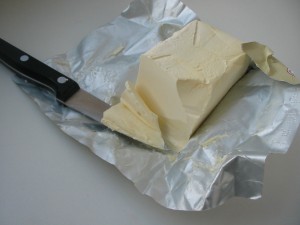
Margarine, RIP (Credit: Kagor at the Ukrainian language Wikipedia)
Forrest Gump famously told us that “life is like a box of chocolates, you never know what you’re gonna get.” And while life does throw us curveballs we still need to be wary of that box of chocolates, among other processed foods. A danger of eating prepackaged and processed foods is the cleverly hidden and often esoteric ingredient list. Though ingredients are printed on all packaging, unless one wants to spend over an hour in every aisle at the grocery store it is likely that the list of ingredients is never fully parsed. So it comes as a nutritional victory that the F.D.A. recently banned one of the worst offenders in packaged and frozen food: trans fatty acids.
Trans fats differ from naturally occurring fats via their bonding structure. Conventional (cis) fats are arranged so that they cannot easily pack together and thus retain fluidity, while trans fats can stack together. This stabilizes the fat, causing it to be difficult to break down. It also allows the molecules to be solid at room temperature, making them ideal additives to extend the shelf lives of various foods. However this is not the only problem with trans fats, as they also create an increase in our ‘bad’ cholesterol levels. This type of cholesterol (LDL) is known to contribute heavily to heart disease, and the trans fatty acid ban is expected to prevent nearly 20,000 heart attacks per year in the United States.
But the black sheep of the food industry wasn’t always so bad. The reaction responsible for producing trans fats, partial hydrogenation, even earned French inventor Paul Sabatier a Nobel Prize in 1912. However many decades later, the detrimental health effects of trans fats began to appear. These health correlations were examined in the 1980s, though it was not until 2003 that the F.D.A. mandated that trans fats must be included in the Nutrition Facts panel on all food packaging (this regulation went into effect in 2006). The mandate successfully reduced trans fat consumption by approximately 80 percent, though even small amounts of the fats can be still be harmful. Two years ago the F.D.A. stated that trans fats were no longer “generally recognized as safe” and began to work on banning them altogether.
The ban gives the food industry three years to remove the fats from products, however it is still possible that companies may attempt to petition the F.D.A. to reserve the right to use trans fats. Currently trans fats are typically found in frying oil, pie crust, margarine, shortening, frosting, pancake mix, non-dairy creamer, and popcorn, though the list is not exhaustive. So how will trans fats be replaced? The verdict remains unclear, as trans fats have been popular additives because they have the capacity to be solid at room temperature but melt at physiological temperatures. One option currently being examined is palm oil, however excessive use of this oil can be devastating for the environment. This can cause rainforest deforestation, as the demand for palm oil grows. The United States already uses nearly 3 million metric tons of palm oil, and this number is predicted to rapidly grow over the next 3 years.
But this is not to say that finding healthy and environmentally responsible alternatives is impossible, as many other countries have implemented similar bans with apparent ease. Over the last decade trans fats have virtually vanished from most foods in Denmark, to the point that Danish trans fat expert Steen Stender says, “In Denmark we don’t mention trans fat. It is a word you do not heed to know or care about it.”
